Klein Tools VDV512-100 Handleiding
Klein Tools
Meetapparatuur
VDV512-100
Bekijk gratis de handleiding van Klein Tools VDV512-100 (9 pagina’s), behorend tot de categorie Meetapparatuur. Deze gids werd als nuttig beoordeeld door 50 mensen en kreeg gemiddeld 4.7 sterren uit 25.5 reviews. Heb je een vraag over Klein Tools VDV512-100 of wil je andere gebruikers van dit product iets vragen? Stel een vraag
Pagina 1/9

GENERAL SPECIFICATIONS
The Klein Tools Coax Explorer® 2 verifies proper continuity of F-connector coaxial cables and
maps their location. The color-coded push-on remotes allow for up to four cables to be tested
and mapped, displaying cable status via LED indicators (PASS OPEN SHORT, , or ) that also
identify the cable/remote location.
• Environment: Indoor
• Operating Altitude: 10000 ft. (3000 m) maximum
• Operating Temperature: ° ° ° °32 to 122 F (0 to 50 C)
• Storage Temp: ° ° ° °-4 to 140 F (-20 to 60 C)
• Relative Humidity: 10% to 90% non-condensing
• Dimensions (including remote holder): 5.7" x 2.3" x 1.1" (145 x 32 x 29 mm)
• Weight (including batteries): 4.8 oz. (136 g)
Specifications subject to change.
TESTING/MAPPING CABLES
NOTE: Not for use on powered circuits or outlets.
1. Connect a test remote
1
,
2
,
3
or
4
to one end of the cable or outlet to be
tested. If necessary, use the included F-adapter
9
to connect the test remote to the
cable. If mapping, install remaining remotes to additional locations.
2. Connect the opposite end of the cable or outlet to be tested to the F-connector
5
on
the Coax Explorer® 2.
3. Press and hold the button TEST 10 . If the cable is wired correctly, one of the four PASS
LEDs 11 will light, also indicating the cable/remote location. If there is a problem with
the cable, one of the FAULT OPEN LEDs ( 12 or SHORT 13 ) will light.
4. Repeat steps 2 and 3 to test/map additional cables.
TESTING AN UNINSTALLED CABLE
1. Using the included F-adapter
9
, connect a test remote
1
to one end of the cable to be
tested.
2. Connect the opposite end of the cable to be tested to the F-connector
5
on the Coax
Explorer® 2.
3. Press and hold the button TEST 10 . If the cable is wired correctly, the corresponding
PASS LED 11 will light. If there is a problem with the cable, one of the FAULT LEDs
( OPEN 12 or SHORT 13 ) will light.
REMOTE HOLDER/STORAGE
The test remotes conveniently snap into the remote holder
8
for storage. To store the
included F-adapter
9
, push two remotes onto the adapter before snapping the remotes into
the holder.
The remote holder snaps onto the body of the Coax Explorer®
2 and may be removed if
desired. Hold the tester in one hand and apply slight downward pressure to one side of the
remote holder with the other hand to release it from the tester. To reattach, align the holder
with the tester body and snap back into place.
BATTERY REPLACEMENT (FIG. 1)
When the TEST button is pressed and no LEDs light, the batteries must be replaced.
1. Unscrew the battery cap
6
.
2. Remove and recycle the two spent AAA batteries
7
.
3.
Install two new AAA batteries, with the positive (+) side facing into the tester as shown.
4. .Screw battery cap tightly back into place
STORAGE
Remove the batteries when the tester is not in use for a prolonged period of time. Do not expose
to high temperatures or humidity. After a period of storage in extreme conditions exceeding the
limits mentioned in the GENERAL SPECIFICATIONS section, allow the tester to return to normal
operating conditions before using.
FCC AND IC COMPLIANCE
See this product’s page at for FCC compliance information.www.kleintools.com
Canada ICES-003 (B) / NMB-003 (B)
WARRANTY
www.kleintools.com/warranty
DISPOSAL / RECYCLE
Do not place equipment and its accessories in the trash. Items must be properly
disposed of in accordance with local regulations. Please see
www.epa.gov/recycle for additional information.
CUSTOMER SERVICE
KLEIN TOOLS, INC.
450 Bond Street, Lincolnshire, IL 60069 1-800-553-4676
customerservice@kleintools.com www.kleintools.com
FIG. 1
5
8
1 3
10
12
13
11
4
9
2
14
7
6
ENGLISH
ENGLISH
1.
Test Remote #1 (Red)
2.
Test Remote #2 (Blue)
3.
Test Remote #3 (Green)
4.
Test Remote #4 (Black)
5.
F-Connector
6.
Battery Cap
7.
2x AAA Batteries
(included)
8.
Remote Holder
9.
F-Adapter
10.
TEST Button
11.
PASS LEDs
12.
OPEN Fault LED
13.
SHORT Fault LED
14.
Pocket Clip (Back)
NOTE: There are no
user-serviceable
parts inside tester.
VDV512-101 Instructions
BASED ON 1330430 Rev. 11/21 E

ESPECIFICACIONES GENERALES
El probador Coax Explorer® 2 de Klein Tools verifica la continuidad apropiada de los cables coaxiales
con conectores F y mapea su ubicación. Los transmisores remotos a presión codificados por color
permiten probar y mapear hasta cuatro cables, y los indicadores LED (PASS ["PRUEBA APROBADA"]
OPEN SHORT ["CIRCUITO ABIERTO"] o ["CORTOCIRCUITO"]) muestran el estado de loscables e
identifican la ubicación del cable/transmisor remoto.
• Entorno: Interior
• Altitud de funcionamiento: 10000pies (3000 m) como máximo
• Temperatura de operación: ° ° ° °32 F a 122 F (0 C a 50 C)
• Temperatura de almacenamiento: ° ° ° °-4 F a 140 F (-20 C a 60 C)
• Humedad relativa: 10% a 90%, sin condensación
• Dimensiones (incluido el portatransmisor): 5,7" × 2,3" × 1,1" (145mm × 32mm × 29mm)
• Peso (incluidas las baterías): 4,8 oz (136 g)
Especificaciones sujetas a cambios.
PRUEBA Y MAPEO DE CABLES
NOTA: No utilizar en circuitos o tomacorrientes con energía.
1. Conecte un transmisor remoto de prueba
1
,
2
,
3
o
4
a un extremo del cable o al
tomacorriente que desee probar. Si es necesario, utilice el adaptador F
9
provisto para
conectar el transmisor remoto de prueba al cable. En caso de que realice un mapeo, instale los
transmisores remotos restantes en ubicaciones adicionales.
2. Conecte el otro extremo del cable o el tomacorriente que desee probar al conector F
5
en el
probador Coax Explorer® 2.
3.
Mantenga presionado el botón ("PROBAR") TEST
10
. Si el cable está correctamente cableado,
se encenderá uno de los cuatro LED PASS ("PRUEBA APROBADA")
11
, que también indicará la
ubicación del cable/transmisor remoto. Si hay un problema en el cable, se encenderá uno delos LED
FAULT ("FALLA") ( ["CIRCUITO ABIERTO"] OPEN
12
o ["CORTOCIRCUITO"] SHORT
13
).
4. Repita los pasos 2 y 3 para probar/mapear otros cables.
PRUEBA DE UN CABLE NO INSTALADO
1. Utilice el adaptador F
9
, provisto para conectar el transmisor remoto de prueba
1
a un
extremo del cable que desee probar.
2. Conecte el otro extremo del cable que desee probar al conector F
5
en el probador
coaxialExplorer® 2.
3. Mantenga presionado el botón TEST ("PROBAR")
10
. Si el cable está correctamente cableado,
se encenderá el LED PASS ("PRUEBA APROBADA")
11
. Si hay un problema con el cable,
se encenderá uno de los LED FAULT ("FALLA") (OPEN [CIRCUITO ABIERTO]
12
o SHORT
[CORTOCIRCUITO]
13
).
PORTATRANSMISOR REMOTO/ALMACENAMIENTO
Los transmisores remotos de prueba calzan a presión cómodamente en el portatransmisor
remoto
8
para su almacenamiento. Para guardar el adaptador F provisto
9
, presione dos
transmisores remotos hacia el interior del adaptador antes de calzar los transmisores remotos en el
portatransmisor.
El portatransmisor remoto calza en el cuerpo del probador Coax Explorer® 2 y se puede extraer, si
se desea. Sostenga el probador con una mano y, con la otra mano, presione levemente uno de los
costados del portatransmisor remoto hacia abajo para liberarlo del probador. Para volver a calzarlo,
alinee el portatransmisor con el cuerpo del probador y cálcelonuevamente en su lugar.
REEMPLAZO DE LAS BATERÍAS (FIG. 1)
Las baterías deben reemplazarse si no se enciende ningún LED al presionar el botón TEST ("PROBAR").
1. Desenrosque la tapa del compartimento de baterías
6
.
2. Retire y recicle las dos baterías AAA agotadas
7
.
3. Instale dos baterías AAA nuevas con el lado positivo (+) orientado hacia el probador, comose
muestra.
4. Enrosque la tapa del compartimento de baterías firmemente en su lugar.
ALMACENAMIENTO
Retire las baterías si no va a utilizar el probador durante un tiempo prolongado. No lo exponga a la
humedad ni a altas temperaturas. Luego de un período de almacenamiento en condiciones extremas
que sobrepasen los límites mencionados en la sección ESPECIFICACIONES GENERALES, deje que el
probador vuelva a las condiciones de funcionamiento normales antes de utilizarlo.
CONFORMIDAD CON LA NORMATIVA FCC/IC:
Puede leer la información sobre la normativa FCC para este producto en www.kleintools.com.
ICES-003 (B)/NMB-003 (B) de Canadá
GARANTÍA
www.kleintools.com/warranty
ELIMINACIÓN/RECICLAJE
No arroje el equipo ni sus accesorios a la basura. Los elementos se deben desechar
correctamente de acuerdo con las regulaciones locales. Para obtener másinformación,
consulte www.epa.gov/recycle.
SERVICIO AL CLIENTE
KLEIN TOOLS, INC.
450 Bond Street, Lincolnshire, IL 60069 1-800-553-4676
customerservice@kleintools.com www.kleintools.com
FIG. 1
5
8
1 3
10
12
13
11
4
9
2
14
7
6
1. Transmisor remoto
de prueba n.º1 (rojo)
2. Transmisor remoto
de prueba n.º2 (azul)
3. Transmisor remoto
de prueba n.º3 (verde)
4. Transmisor remoto
de prueba n.º4 (negro)
5. Conector F
6. Tapa del compartimento de baterías
7. 2baterías AAA (incluidas)
8. Portatransmisor remoto
9. Adaptador F
10. Botón TEST ("PROBAR")
11. LED que indica PASS ("PRUEBAAPROBADA")
12. LED FAULT ("FALLA") que indica OPEN ("CIRCUITO ABIERTO")
13. LED FAULT ("FALLA") que indica SHORT ("CORTOCIRCUITO")
14. Clip de bolsillo (espalda)
NOTA: El probador no contiene en su interior piezas que
el usuario puedareparar.
ESPAÑOL
VDV512-101 Instrucciones
BASADO EN 1330430 REV. 11/21 E

CARACTÉRISTIQUES GÉNÉRALES
Le CoaxExplorer®2 de KleinTools vérifie la continuité des câbles coaxiaux à connecteur enF et
mappe leur emplacement. Les capteurs à distance chromocodés à enfiler permettent de tester et de
mapper jusqu’à 4câbles en indiquant l’état de chacun d’eux par des voyantsDEL («PASS» [test
réussi], « » [circuit ouvert] ou «OPEN SHORT» [court-circuit]), qui précisent aussi l’emplacement du
câble et du capteur à distance.
• Environnement: À l’intérieur
• Altitude de fonctionnement: 3000m (10000pi) maximum
• Température de fonctionnement: ° ° ° °0 C à 50 C (32 F à 122 F)
• Température d’entreposage: ° ° ° °-20 C à 60 C (-4 F à 140 F)
• Humidité relative: 10 à 90%, sans condensation
• Dimensions (incluant le support pour capteurs à distance): 145x 32x 29mm
(5,7x 2,3x 1,1po)
• Poids (avec les piles): 136g (4,8oz)
Les caractéristiques techniques peuvent faire l’objet de modifications.
TEST ET MAPPAGE DES CÂBLES
REMARQUE: Évitez l’utilisation sur des prises et des circuits alimentés.
1. Connectez le capteur de test à distance
1
,
2
,
3
ou
4
à une extrémité du câble ou de la
prise à tester. Au besoin, utilisez l’adaptateur de connecteur enF
9
inclus pour connecter le
capteur de test à distance au câble. Lors du mappage, répartissez les autres capteurs de test à
distance entre divers emplacements.
2. Connectez l’extrémité opposée du câble ou de la prise à tester au connecteur enF
5
sur
le Coax Explorer® 2.
3. TEST Appuyez sur le bouton « »
10
et maintenez-le enfoncé. Si le câblage est correct, un des
4voyantsDEL «PASS» (test réussi)
11
s’allumera et indiquera aussi l’emplacement
du câble et
ducapteur à distance. Si un problème survient avec le câble, un des voyantsDEL
FAULT (anomalie)
(« » [circuit ouvert] OPEN
12
ou « » [court-circuit] SHORT
13
) s’allumera.
4. Répétez les étapes2 et 3 pour tester ou mapper d’autres câbles.
TEST D’UN CÂBLE NON INSTALLÉ
1. À l’aide de l’adaptateur de connecteur enF
9
compris, connectez le capteur de test à distance
1
à une extrémité du câble à tester.
2. Connectez l’extrémité opposée du câble à tester au connecteur enF
5
sur le CoaxExplorer®2.
3. Appuyez sur le bouton «TEST»
10
. et maintenez-le enfoncé. Si le câblage est correct, le
voyantDEL «PASS»
11
(test réussi) correspondant s’allumera. Si un problème survient avec
le câble, un des voyantsDEL FAULT (anomalie) («OPEN»
12
[circuit ouvert] ou «SHORT»
13
[court-circuit]) s’allumera.
SUPPORT POUR TENIR ET ENTREPOSER LES CAPTEURS À DISTANCE
Les capteurs de test à distance se placent facilement sur le support
8
pour être entreposés.
Pour entreposer l’adaptateur de connecteur enF inclus
9
, placez deux capteurs à distance
surl’adaptateur avant de les fixer sur le support.
Le support pour capteurs à distance se fixe au boîtier du CoaxExplorer®2 et peut être retiré au besoin.
Tenez le testeur dans une main et, de l’autre, appuyez doucement vers le bas sur un côté du support
afin de le détacher du testeur. Pour le fixer à nouveau, alignez le support avec leboîtier du testeur, puis
appuyez.
REMPLACEMENT DES PILES (FIG. 1)
Lorsque vous enfoncez le bouton «TEST» et qu’aucun voyantDEL ne s’allume, remplacez lespiles.
1. Dévissez le couvercle du compartiment à piles
6
.
2. Retirez et recyclez les deux pilesAAA à plat
7
.
3. Placez deux nouvelles pilesAAA dans le testeur, côté positif (+) vers le haut, comme illustré.
4. Replacez le couvercle du compartiment à piles en le vissant bien serré.
ENTREPOSAGE
Retirez les piles lorsque vous ne prévoyez pas utiliser le testeur pendant une longue période.
N’exposez pas l’appareil à des températures ou à un taux d’humidité élevés. Après une période
de stockage dans des conditions extrêmes (hors des limites mentionnées dans la section
CARACTÉRISTIQUES GÉNÉRALES), laissez le testeur revenir à des conditions d’utilisation normales
avant de l’utiliser.
CONFORMITÉ FCC ET IC
Consultez la page de ce produit à l’adresse www.kleintools.com pour obtenir des
renseignements sur la conformité à la Federal Communications Commission (FCC).
Canada ICES-003 (B)/NMB-003 (B)
GARANTIE
www.kleintools.com/warranty
MISE AU REBUT/RECYCLAGE
Ne mettez pas l’appareil et ses accessoires au rebut. Ces articles doivent
être éliminés conformément aux règlements locaux. Pour de plus amples
renseignements, consultez les sites www.epa.gov/recycle.
SERVICE À LA CLIENTÈLE
KLEIN TOOLS, INC.
450 Bond Street, Lincolnshire, IL 60069 1-800-553-4676
customerservice@kleintools.com www.kleintools.com
1. Capteur de test à distance n
o
1 (rouge)
2. Capteur de test à distance n
o
2 (bleu)
3. Capteur de test à distance n
o
3 (vert)
4. Capteur de test à distance n
o
4 (noir)
5. Connecteur enF
6. Couvercle de piles
7. 2pilesAAA (comprises)
8. Support pour capteurs à distance
9. Adaptateur de connecteur enF
10. Bouton «TEST»
11. VoyantsDEL «PASS» (test réussi)
12.
VoyantDEL «FAULT» (anomalie)
indiquant «OPEN» (circuit ouvert)
13.
VoyantDEL «FAULT» (anomalie)
indiquant «SHORT» (court-circuit)
14. Agrafe pour poche (à l’arrière)
REMARQUE: Ce testeur ne contient
aucune pièce réparable par l’utilisateur.
FIG. 1
5
8
1 3
10
12
13
11
4
9
2
14
7
6
FRANÇAIS
VDV512-101 Directives
BASÉ SUR 1330430 RÉV. 11/21 E
Product specificaties
| Merk: | Klein Tools |
| Categorie: | Meetapparatuur |
| Model: | VDV512-100 |
| Gewicht: | 85 g |
| Breedte: | 32 mm |
| Diepte: | 146 mm |
| Hoogte: | 25 mm |
| Ondersteund aantal accu's/batterijen: | 2 |
| Type batterij: | AAA |
| Ondersteunde aansluitingen: | BNC, RJ-11 |
Heb je hulp nodig?
Als je hulp nodig hebt met Klein Tools VDV512-100 stel dan hieronder een vraag en andere gebruikers zullen je antwoorden
Handleiding Meetapparatuur Klein Tools
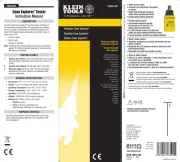
8 Juli 2025
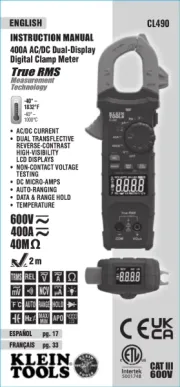
14 April 2025

13 Januari 2025

13 Januari 2025

18 November 2024

12 November 2024

24 September 2024

21 September 2024

21 September 2024

18 Juni 2024
Handleiding Meetapparatuur
- AREXX
- Crowcon
- Fluke
- Makita
- Truelife
- Panasonic
- Stabila
- Weidmüller
- YSI
- Soehnle
- SKS
- Schneider
- Mitsubishi
- Grohe
- Hager
Nieuwste handleidingen voor Meetapparatuur
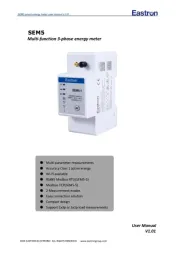
29 Juli 2025
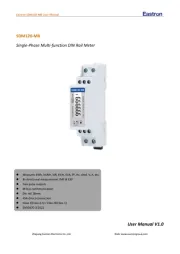
29 Juli 2025
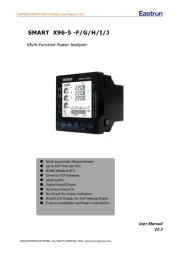
29 Juli 2025

29 Juli 2025
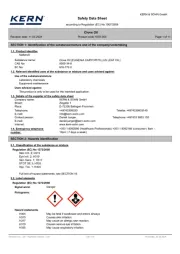
29 Juli 2025
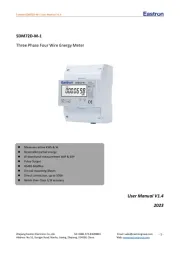
29 Juli 2025
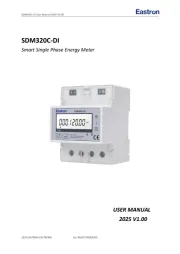
28 Juli 2025
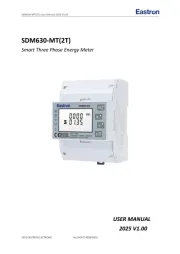
28 Juli 2025
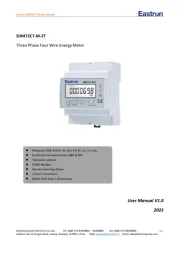
28 Juli 2025
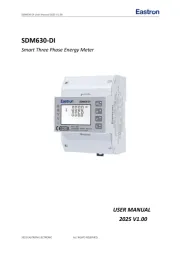
28 Juli 2025